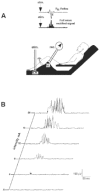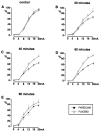Constitutive cyclooxygenase-2 is involved in central nociceptive processes in humans
- PMID: 17457134
- PMCID: PMC3984587
- DOI: 10.1097/01.anes.0000265162.39932.33
Constitutive cyclooxygenase-2 is involved in central nociceptive processes in humans
Abstract
Background: Prostaglandins play a major role in inflammation and pain. They are synthesized by the two cyclooxygenase (COX) isoforms: COX-1, which is expressed constitutively in many cell types, and COX-2, which is induced at the site of inflammation. However, unlike peripheral tissues, COX-2 is expressed constitutively in the central nervous system and may play a role in nociceptive processes. The current study aimed to investigate the role of constitutive COX-2 in the spinal transmission of nociceptive signals in humans.
Methods: The authors used 12 healthy volunteers to compare the effects of the specific COX-2 inhibitor sodium parecoxib (1 mg/kg) or placebo, administered intravenously in a double-blind and crossover fashion, on the electrophysiologic recordings of the nociceptive flexion (RIII) reflex. The RIII reflex is an objective psychophysiologic index of the spinal transmission of nociceptive signals and was recorded from the biceps femoris after electrical stimulation of the sural nerve. Two experiments, 7 days apart, were conducted in each volunteer. On each experimental day, the effects of parecoxib or placebo were tested on (1) the RIII reflex threshold, (2) the stimulus-response curves of the reflex up to the tolerance threshold (frequency of stimulation: 0.1 Hz), and (3) the progressive increase of the reflex and pain sensations (i.e., "windup" phenomenon) induced by a series of 15 stimulations at a frequency of 1 Hz (intensity 20% above RIII threshold).
Results: Parecoxib, but not placebo, significantly reduced the slope of the stimulus-response curve, suggesting a reduction in the gain of the spinal transmission of nociceptive signals. By contrast, the windup phenomenon was not significantly altered after administration of parecoxib or placebo.
Conclusions: This study shows that constitutive COX-2 modulates spinal nociceptive processes and that the antiinflammatory and antinociceptive actions of COX-2 inhibitors are not necessarily related.
Figures




Similar articles
-
The effects of ketamine on the temporal summation (wind-up) of the R(III) nociceptive flexion reflex and pain in humans.Anesth Analg. 2000 Feb;90(2):408-14. doi: 10.1097/00000539-200002000-00031. Anesth Analg. 2000. PMID: 10648330 Clinical Trial.
-
Interaction of a combination of morphine and ketamine on the nociceptive flexion reflex in human volunteers.Pain. 2002 Jul;98(1-2):47-57. doi: 10.1016/s0304-3959(01)00472-9. Pain. 2002. PMID: 12098616 Clinical Trial.
-
Nefopam strongly depresses the nociceptive flexion (R(III)) reflex in humans.Pain. 1999 Mar;80(1-2):399-404. doi: 10.1016/s0304-3959(98)00238-3. Pain. 1999. PMID: 10204754 Clinical Trial.
-
The lower limb flexion reflex in humans.Prog Neurobiol. 2005 Dec;77(6):353-95. doi: 10.1016/j.pneurobio.2005.11.003. Epub 2005 Dec 28. Prog Neurobiol. 2005. PMID: 16386347 Review.
-
The spinal phospholipase-cyclooxygenase-prostanoid cascade in nociceptive processing.Annu Rev Pharmacol Toxicol. 2002;42:553-83. doi: 10.1146/annurev.pharmtox.42.092401.143905. Annu Rev Pharmacol Toxicol. 2002. PMID: 11807183 Review.
Cited by
-
COX-2 expression and function in the hyperalgesic response to paw inflammation in mice.Prostaglandins Leukot Essent Fatty Acids. 2008 Dec;79(6):183-90. doi: 10.1016/j.plefa.2008.08.001. Epub 2008 Oct 1. Prostaglandins Leukot Essent Fatty Acids. 2008. PMID: 18829279 Free PMC article.
-
Parecoxib added to ropivacaine prolongs duration of axillary brachial plexus blockade and relieves postoperative pain.Clin Orthop Relat Res. 2013 Feb;471(2):562-8. doi: 10.1007/s11999-012-2691-y. Epub 2012 Nov 21. Clin Orthop Relat Res. 2013. PMID: 23179117 Free PMC article. Clinical Trial.
-
Cyclooxygenase-2 negatively regulates osteogenic differentiation in murine bone marrow mesenchymal stem cells via the FOXO3a/p27kip1 pathway.Bone Joint Res. 2025 May 8;14(5):407-419. doi: 10.1302/2046-3758.145.BJR-2024-0262.R2. Bone Joint Res. 2025. PMID: 40335058 Free PMC article.
-
Platelet-Mediated Transfer of Cardioprotection by Remote Ischemic Conditioning and Its Abrogation by Aspirin But Not by Ticagrelor.Cardiovasc Drugs Ther. 2023 Oct;37(5):865-876. doi: 10.1007/s10557-022-07345-9. Epub 2022 May 21. Cardiovasc Drugs Ther. 2023. PMID: 35595877 Free PMC article.
-
Effects of measurement posture and stimulation intensity on the nociceptive flexion reflex (RIII reflex).J Phys Ther Sci. 2017 Jun;29(6):1066-1069. doi: 10.1589/jpts.29.1066. Epub 2017 Jun 7. J Phys Ther Sci. 2017. PMID: 28626326 Free PMC article.
References
-
- Vane JR. Inhibition of prostaglandin synthesis as a mechanism of action for aspirin- like drugs. Nat New Biol. 1971;231(25):232–235. - PubMed
-
- Burian M, Geisslinger G. COX-dependent mechanisms involved in the antinociceptive action of NSAIDs at central and peripheral sites. Pharmacol Ther. 2005;107:139–154. - PubMed
-
- Ito S, Okuda-Ashitaka E, Minami T. Central and peripheral roles of prostaglandins in pain and their interactions with novel neuropeptides nociceptin and nocistatin. Neurosci Res. 2001;41:299–332. - PubMed
-
- Simmons DL, Botting RM, Hla T. Cyclooxygenase isozymes: the biology of prostaglandin synthesis and inhibition. Pharmacol Rev. 2004;56:387–437. - PubMed
-
- Stichtenoth DO, Frolich JC. The second generation of COX- 2 inhibitors: what advantages do the newest offer? Drugs. 2003;63:33–45. - PubMed
Publication types
MeSH terms
Substances
LinkOut - more resources
Full Text Sources
Medical
Research Materials

